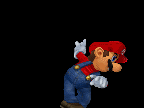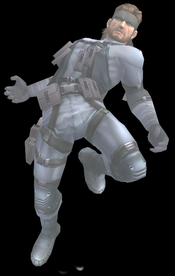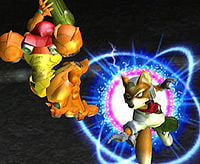Air dodge: Difference between revisions
(it's not that important to have possessive terms as part of a link, simpler table coding) |
m (just noticed something really minor) |
||
| Line 29: | Line 29: | ||
====Air dodge invincibility and lag in ''Brawl''==== | ====Air dodge invincibility and lag in ''Brawl''==== | ||
The table here displays the frame data for the air dodge of every ''Brawl'' character. Every character has a certain amount of frames taken to perform an air dodge, and the invincibility frames starts and ends in between the total frames taken. Most character's invincibility usually starts on frame 4 and end about 10 or 20 frames before the end of the entire air dodge; however there are a few exceptions. | The table here displays the frame data for the air dodge of every ''Brawl'' character. Every character has a certain amount of frames taken to perform an air dodge, and the invincibility frames starts and ends in between the total frames taken. Most character's invincibility usually starts on frame 4 and end about 10 or 20 frames before the end of the entire air dodge; however, there are a few exceptions. | ||
{| class="wikitable sortable" style="text-align:center;" | {| class="wikitable sortable" style="text-align:center;" | ||
!Characters | !Characters | ||
Revision as of 11:55, June 6, 2014
Air dodging (or EscapeAir by internal Brawl files) is a technique in Super Smash Bros. Melee and Super Smash Bros. Brawl that gives temporary invincibility frames to the user in the air, preventing attacks from hitting them. It can be described as sidestepping in midair.
Overview
In Super Smash Bros. Melee
In Melee, an air dodge is performed by fully pressing L or R while in the air. Air dodging cannot be done if the character is tumbling or reeling. The air dodge halts the character's momentum; it leaves the character hovering if the Control Stick is not tilted, and when the Control Stick is tilted, the air dodge gives the character a small boost in its direction. This boost can aid one's recovery, though most air dodging characters cannot sweet spot the ledge. Furthermore, most third jumps outreach the air dodge, making it more beneficial for sweet spotting the ledge in most situations.
During the air dodge, the character cannot be hit by attacks, but then enters a helpless state and falls to the ground.
Air dodging into the ground is known as wavelanding, which is the primary component of the wavedash.
Using air dodging as a recovery

An angled recovery is the opposite of wavedashing, since the player angles the control stick up. An angled recovery is useful when a player gets knocked off a stage that has multiple platforms, such as Temple.
In order to perform an angled recovery, the player must hold the control stick up diagonally and air dodge. The angled recovery has less lag time compared to a character's normal recovery and it can't be negated since the player invincible, but it generally doesn't go as far as a character's usual recovery move. The angled recovery is useful when the player is at the peak of their second jump from a short vertical distance off the side of the stage and a short horizontal distance. If the player is too far away, they will fall and receive a self-destruct. The player can also perform this at far distances only if they're at a very high altitude. The angled recovery is effective when the character's second jump isn't enough to make it back to the stage, but is close enough for where an air dodge will cover the remaining recovery distance.
Angled recoveries are most beneficial for Jigglypuff and Yoshi, since their up B attacks do not give any recovery distance, though with Jigglypuff her jumps and Rising Pound can usually get her back to the stage anyway. Angled recoveries are also particularly helpful to a lone Popo, who lacks a proper vertical recovery move. Air dodging does not lead the user immediately into helplessness, so that characters that have wall-grapples can use it out of an air dodge. A similar maneuver allows to grab items while air dodging.
Characters with effective recoveries (including side special moves) such as Falco (Fire Bird and Falco Phantasm), Peach (floating and Peach Parasol), Fox (Fire Fox and Fox Illusion), Marth (Dolphin Slash and Dancing Blade), and Pikachu (Quick Attack and Skull Bash), rarely need to use the angled recovery or elevated recovery since their recoveries are tougher to block if done with proper timing.
In Super Smash Bros. Brawl
In Brawl, the air dodge has been revamped. It no longer halts the character's momentum and no longer permits the user to nudge the character by pressing the control stick. It simply grants brief invincibility along the character's current line of movement. Following the air dodge, characters are put in their regular aerial state rather than the helpless state, and thus may attack, jump, or air dodge again following their initial air dodge.
The air dodge can now also be used when a character is tumbling or reeling, and is often employed by players to enable action quicker than waiting out their knockback and to limit reliance on teching. Using the air dodge at this time does not reduce knockback, a rumor that was started when it was noticed that higher-level CPUs were doing it constantly. However, an air dodge can be used for momentum canceling, and in some cases, such as Ike and Snake, it is their best option, since they yield better results using an air dodge when momentum canceling than their shortest lasting aerial (both of their air dodges end in 39 frames, while their shortest lasting aerials last just a few frames longer, and despite the miniscule difference, air dodging is still their best option nonetheless). In addition, they also gain the most benefit when Momentum Canceling using the basic method.
Air dodging will cause the character to automatically catch any item nearby during the first frames; however, This does not work if the character already has an item.
Air dodge invincibility and lag in Brawl
The table here displays the frame data for the air dodge of every Brawl character. Every character has a certain amount of frames taken to perform an air dodge, and the invincibility frames starts and ends in between the total frames taken. Most character's invincibility usually starts on frame 4 and end about 10 or 20 frames before the end of the entire air dodge; however, there are a few exceptions.
| Characters | Invincibility Frames | Total Frames |
|---|---|---|
| Meta Knight | 3-29 | 39 |
| Zero Suit Samus | 4-29 | 39 |
| Diddy Kong | 4-29 | 39 |
| Pit | 4-29 | 39 |
| Squirtle | 4-29 | 39 |
| Ivysaur | 4-29 | 39 |
| Charizard | 4-29 | 39 |
| Ike | 4-29 | 39 |
| Snake | 4-29 | 39 |
| King Dedede | 4-29 | 39 |
| Lucario | 4-29 | 39 |
| Wario | 4-29 | 39 |
| R.O.B. | 4-29 | 39 |
| Olimar | 4-29 | 39 |
| Ice Climbers | 4-29 | 48 |
| Ness | 4-29 | 48 |
| Sonic | 4-29 | 48 |
| Lucas | 4-29 | 48 |
| Bowser | 4-30 | 49 |
| Mario | 4-29 | 49 |
| Donkey Kong | 4-29 | 49 |
| Link | 4-29 | 49 |
| Samus | 4-29 | 49 |
| Kirby | 4-29 | 49 |
| Fox | 4-29 | 49 |
| Pikachu | 4-29 | 49 |
| Mr. Game & Watch | 4-29 | 49 |
| Luigi | 4-29 | 49 |
| Zelda | 4-29 | 49 |
| Sheik | 4-29 | 49 |
| Falco | 4-29 | 49 |
| Yoshi | 4-29 | 49 |
| Ganondorf | 4-29 | 49 |
| Wolf | 4-29 | 49 |
| Toon Link | 4-29 | 49 |
| Captain Falcon | 4-29 | 49 |
| Jigglypuff | 4-29 | 49 |
| Marth | 5-30 | 49 |
| Peach | 4-19 | 49 |


